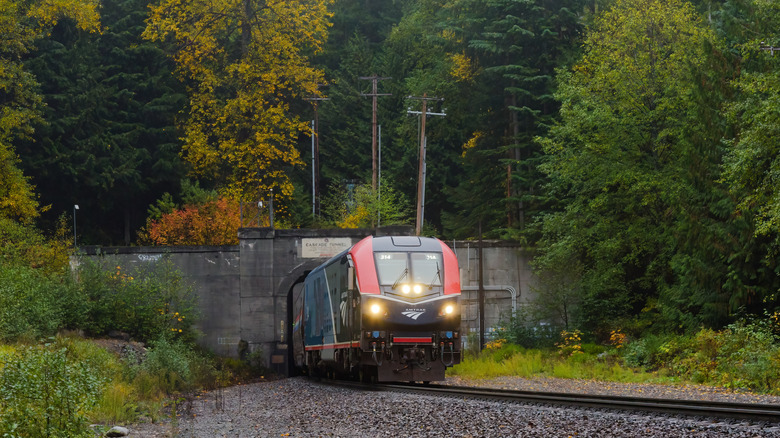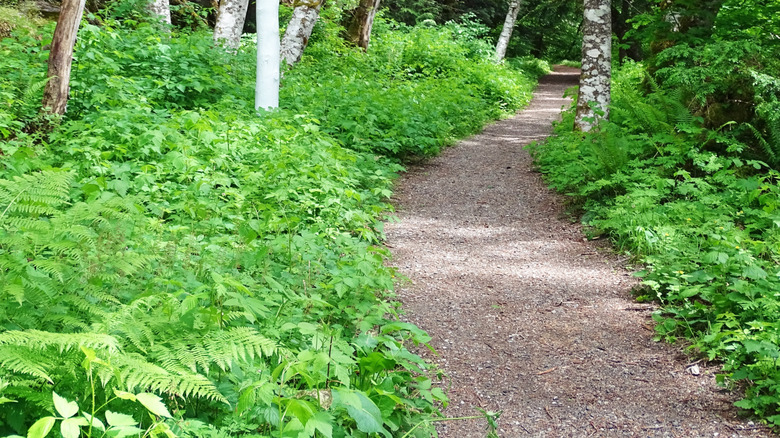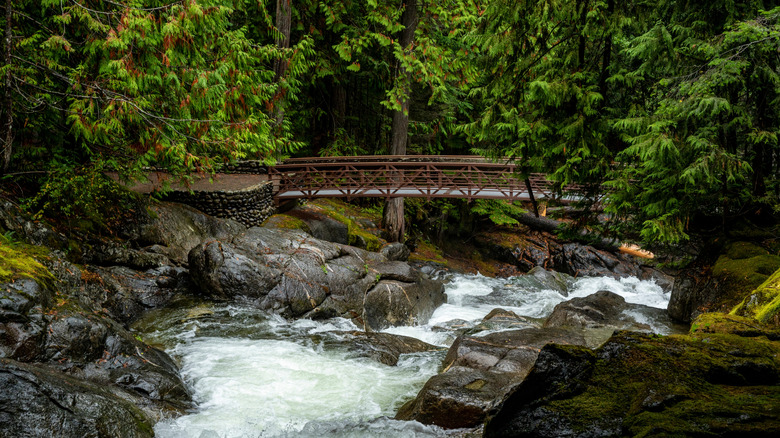America's Longest Railroad Tunnel Is A Pacific Northwest Gem Hidden Within Scenic Hiking Trails Near Seattle
Drive 60 miles east from Everett, Washington, on U.S. Highway 2 and you'll reach the treacherous Stevens Pass in the magnificent Cascades. While the mountain road is known for heavy snowfall and separating Puget Sound from central Washington, it's also the site of two feats of engineering, the Cascade Tunnels. Like the world's first tunnel to connect two countries, the first Cascade Tunnel, built in 1900, revolutionized rail travel as the longest railroad tunnel in the nation. Despite this achievement, the tunnel is surrounded by equal parts of tragedy, beauty, and maybe a few ghosts.
The first 2.63-mile Cascade Tunnel was completed by the Great Northern Railway in 1900 outside of Wellington, Washington, to eliminate a grueling route along a series of switchbacks, where trains would stage and wait to climb, often getting stuck in adverse weather conditions. However, the original Cascade Tunnel had significant problems, including trains being stuck in the snow and smoke from engines causing asphyxiation within the tunnel. After days of relentless snowfall followed by a thunderstorm, tragedy struck on March 1, 1910. An avalanche swept away two snowbound trains, killing 96 people.
Although the Great Northern improved the rail line for winter travel after the disaster and added snowsheds, a second train was hit by an avalanche nearby in 1916, killing eight passengers. Rather than make continuous improvements, between 1925 and 1928, the company constructed a second 7.8-mile Cascade Tunnel, the longest railroad tunnel in America, then and now, at a cost of $14 million. Once completed, the project received tremendous fanfare, though it signaled the end for Wellington, which was renamed Tye.
One of Washington's most unique trails
Hikers, history buffs, and railway aficionados will love exploring the Great Northern Railroad's original path through the Cascades, now dubbed the Iron Goat Trail. While the entire route from west to east encompasses 12 miles, you can tailor the journey to your individual preferences. Groups with kids or mobility-impaired hikers will likely want to start on the lower Martin Creek Trailhead, where the first few miles are ADA-accessible, passing by tunnels and stunning scenery. After about an hour, you'll reach the trail's interpretive site below the switchbacks where you'll find the aptly named area of Scenic, a big red caboose, and tons of photo opportunities, especially if you're bringing the kids.
Muster up the energy and climb the steep zig-zags to the top, then continue about a quarter mile east to the Windy Point Lookout, where you may encounter wildflowers and pikas. While you can directly head back to the Martin Creek Trailhead along the upper trail, venturing a few more miles northeast on the Wellington Trailhead will lead you to the railway ghost town near the avalanche. This trail isn't strenuous, but it may intensify your breathing like visiting one of the most haunted destinations on Earth. Hikers have reported paranormal activity in the tunnels near the town.
At each trailhead, you'll find restrooms, including accessible restrooms at Martin Creek and the interpretive site. Don't forget that each vehicle parked at the Martin Creek or Iron Goat Trailheads will need a $5 recreation pass. Per AllTrails, be sure to wear long clothing and bring plenty of water and bug spray.
An epic trip up Highway 2
U.S. Highway 2 is part of the Cascade Loop, leading to orchards, vineyards, and a gorgeous lake. Whether you're camping for a weekend or are on an epic road trip, there's no shortage of incredible and accessible outdoor adventures here for the whole family. Don't miss visiting two hidden gems just off the highway, including the Deception Falls Interpretive Trail, and a gorgeous, 2-mile hike to Scenic Hot Springs.
Many of the historic towns near the Cascade Tunnel are well worth a stop. Gold Bar is home to Zeke's Drive-In, a family-owned local favorite for refueling after a hike. Train buffs and kids will love the iconic red caboose alongside the restaurant that was built in 1901. Go with their classic Honeymoon Burger that has been on the menu, and unchanged, since 1968, with a chocolate shake, or opt for a locally-inspired elk burger. For accommodations, you'll find affordable cabins, glamping, and a unique yurt in Baring and Skykomish. Or, as long as you're not drowsy, head to Leavenworth, one of the top spots for "sleep tourism" in America, just an hour east.
The easiest way to visit the tunnel is to go right through it. Since the new Cascade Tunnel opened in 1929, the Empire Builder, a train named after the former President of Great Northern, James J. Hill, began regularly making daily 46-hour trips between Chicago and Seattle, stopping in the heavenly Idaho panhandle and Montana along the way. Today, AMTRAK runs the service. If you'd prefer to fly and drive, and are coming from the West Coast, consider flying into Everett's Paine Field Airport (PAE), rather than the Seattle–Tacoma International Airport.


